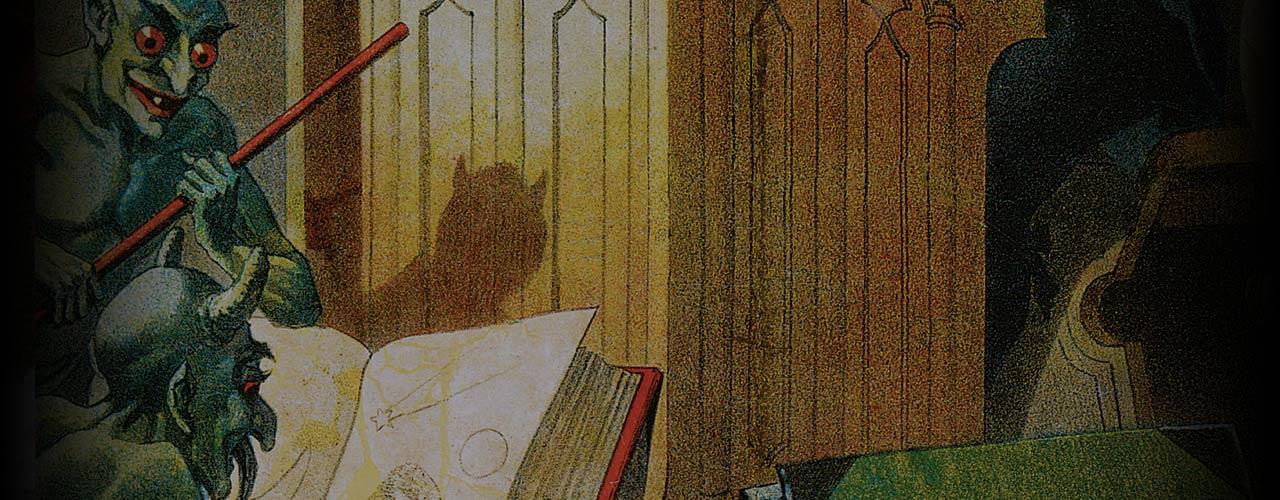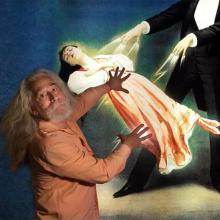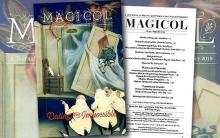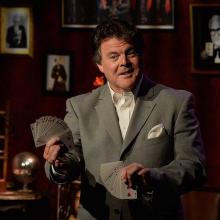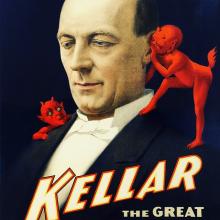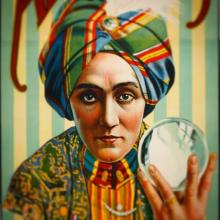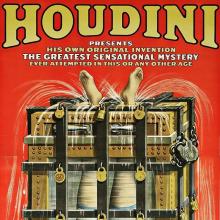Submitted by Jamy Ian Swiss on

The Secret History of Magic
by Peter Lamont and Jim Steinmeyer
Book review by Jamy Ian Swiss
Jim Steinmeyer will require little, if any, introduction to this critic’s readers, considering his renown in the magic world as one of the premiere illusion designers for magicians, theater, and theme parks, and also as the author of invaluable books about magic theory, history, tricks and illusions, for both magicians and the public. Peter Lamont, who is somewhat less widely known but no doubt familiar to many of my readers, is a Research Fellow at the University of Edinburgh, and has written extensively about magic’s history, psychology, and theory. These two accomplished authors have now collaborated for the first time, on a book for the public, entitled The Secret History of Magic.
I am a long-time fan of both writers, having reviewed a number of their books over the years for Genii. I’m particularly fond of Steinmeyer’s essay collections with Art and Artifice being a favorite, I still delight in rereading The Complete Jarrett. I frequently recommend the charming and very readable Hiding the Elephant to non-magicians who are curious to learn more about magic history and theory. From Lamont’s work, The Rise of the Indian Rope Trick is a top personal pick.
Steinmeyer’s work has been published beyond the magic world, including more obscure titles that one would not, at first blush, expect to be so widely circulated. As bystanders, we have little idea about the commercial success of such books, but it’s fair to say that Hiding the Elephant has been both reviewed and read far beyond the borders of the magic community. Kudos to anyone who contributes to raising magic’s worthy profile in the world, as art and history, in a thoughtful and substantive manner.

Marketing to a broader audience often requires reframing and salesmanship, and the title of this new work, with its dubbing as a “secret history,” is doubtlessly intended to assist in that effort. That said, magicians will discover that there is some credibility to the description. Lamont has given a number of talks and published on the general notion of magic’s “creation myths” in recent years, and this new book tackles a number of such tales oft-repeated as gospel within the magic community. It turns out some of these myths are as reliable as the word “gospel” implies—which is to say, not at all.
Among the myths that the authors intend to debunk is the popular (among magicians, at least) story of Jean Eugène Robert-Houdin suppressing an Algerian uprising, at the request of the French government, by performing his illusion “The Light and Heavy Chest” in the guise of being able to apparently rob the Algerian holy men of their physical strength. (Insert sound of “Family Feud” fail buzzer here.)
It will come as no surprise to most who are at all familiar with Robert-Houdin’s legendary pseudo-autobiographical Memoirs of Robert-Houdin that much of the book is self-promoting fiction, albeit a rollicking and inspiring read. The book was a profound influence on a couple of generations of magicians, including Harry Houdini, who famously adopted his stage name from that of Houdin. But as he learned more, Houdini became completely disappointed to realize that Robert-Houdin was not exactly the walk-on-water hero Houdini—as a boy named Erich Weiss—had imagined him to be. Houdini then wrote a scathing, if incompletely researched, attack on his childhood inspiration in The Unmasking of Robert-Houdin.
Readers are carefully escorted through the scarcity of available sources as the authors try to establish what actually happened in Algeria. As it turns out, Robert-Houdin did a profitable little run at a beautiful theater (that still stands today), utilizing much of his professional stage repertoire, of which the chest had been a pre-existing, albeit minor, element. And the only show the Algerian chieftains showed up for was the one they were not merely invited to, but summoned for.

I won’t give away all the spoilers, but tracking the true history is a fun jaunt for readers, especially for magicians who are familiar with the fondly repeated mythology. (And, in the Summer 2018 issue of Gibecière, Steinmeyer provides an even more detailed account of his investigations into this particular story, along with marvelous illustrations not included in The Secret History of Magic.)
In bringing this historical skepticism to the established assumptions of conjuring history, the unearthing of more accurate facts and artifacts makes for enlightening reading, certainly for serious students of this subject matter. While the authors are not entirely dismissive of the oft-misrepresented sources we are most familiar with—one needn’t try to destroy Robert-Houdin’s reputation, as his acolyte Houdini attempted, in the course of correcting the record—they do take Robert-Houdin down a notch from his lofty historical perch. Consider this summarizing sentence about Robert-Houdin’s escapades in Algiers: “He performed his show, and nothing happened.” (If only Christian Fechner were alive to read this material … but then again, that buzz I detect just may be the grave-bound spinning of Robert-Houdin’s late great fan and collector.)
Authors Steinmeyer and Lamont address a number of such creation myths in the history of magic, and also try to dispel and clarify longstanding assumptions often colored by insufficient information, misinformation, bias, or worse. As part and parcel of this historicity-driven perspective, one theme they often return to is that human beings of a mere few centuries ago were not the credulous cretins that history, in general—and magicians in particular—might imagine them to be. That is to say, the notion that the Algerians were unaware that Robert-Houdin was performing feats of conjuring, rather than supernatural miracles, is a belief born of a myopic view of history at best; or in this case, outright racism.
As the authors repeatedly point out, the fact that the Algerians were quite capable of recognizing a magic trick when they saw one is consistent with similar misapprehensions about the past, be it tales of panicked theater-goers running from the Lumière brothers’ film of a locomotive engine coming straight at them, or of radio listeners jumping out of windows during Orson Welles’ infamous War of the Worlds broadcast. Further investigation of these and other such tales routinely bring to light that the myths, while appealing and entertaining, are just that: tales as reliable as those of Odysseus.

Indeed, in discussing Reginald Scot’s classic of Elizabethan literature, The Discoverie of Witchcraft, the authors refer to Scot’s claims—namely that people of the time mistook magic for witchcraft and were persecuted as a result—as “rhetoric,” and then, with fascinating thoroughness, explore “the problem that there was no actual evidence…of anyone being persecuted for performing magic tricks.” While this does not diminish the significance of Scot’s book as a work of skepticism, since Scot’s emphasis in the overall text was on the nature of evidence, the authors’ observation is an interesting one, not only in this case, but also in their subsequent examples of magicians, and others, arguing against the existence of the supernatural.
Of course, the “secret history” bound up in these historical debunkings are not going to fill a book on their own (unless you are simply inventing fiction and conspiracy theories, as we have seen in Houdini biographies of vintages both aged and recent), and so along the way, we get plenty of detail about lesser-known (at least to the public) characters along the path of magic’s history, as recounted by Steinmeyer and Lamont. Our guides clearly acknowledge in the opening page of their prologue that they have chosen to leave out many conjurors, countries, and centuries that might have been discussed, and instead set out to construct their own particular “story that explains what magic has been, what it is, and why it matters.”
This is a worthy task, and fundamentally what renders the book a worthy read for any magician, because the authors consider the history of magic through a long and wide lens, not merely a microscope. One of the dangers of studying history is that it is far too often presented, as one wag put it long ago, as an account of “one damned thing after another.” In fact, it was not until a freshman college class that an instructor handed me a chart framing history along an X-axis of time and a Y-axis of economies (i.e. hunting/gathering, agricultural, feudal, industrial, etc.), which after considering for a few moments left me outraged at how long it had taken, after years of studying history in school, for someone to finally present me with a useful and unifying explanation of a previously random mess of dates and facts.
There have been few such attempts in magic—and even those have often suffered significantly from the limitations of their authors. So the effort to construct a meaningful and understandable overview of the history of magic may well comprise this book’s greatest value for magicians: a chance to consider the random pile of facts we tend to accumulate over time, and try to make some kind of comprehensible sense out of them. And this value remains, whether or not the reader embraces the authors’ perspectives or choice of emphases in every instance.
The early chapters of the book, which look at magic in eras from ancient Egypt to Elizabethan England, set forth the authors’ vision and requisite definitions and may admittedly serve as a bit of an academic slog at times for non-enthusiasts. But I found their repeated attempts to clarify the very nature of magic particularly interesting—namely, the inherent paradox, in which “You are supposed to believe what you see, without believing that it is real;” or, as it is later described, “(audiences) do not believe in magic, but they do believe what they see.” Without seriously engaging with this idea, one cannot apprehend and assess the problem of believing that the view of magic by the ancients was, or was not, significantly different from that of our modern, “enlightened” times. Thus a discussion of the magic of Isaac Fawkes in the context of the philosophers John Locke and David Hume may challenge readers anticipating a lighter ride, but the significance of black swans and white crows will be subjects the authors return to more than a few times, as will the idea that “the purpose of magic is not merely to deceived; it is to demonstrate the seemingly impossible.” These, and more, are important questions for magicians to consider in thinking clearly about the art they create and magic they present.
For magicians unfamiliar with early conjuring literature, Steinmeyer and Lamont take us on a brief tour through the likes of Hocus Pocus Junior, Breslaw, Decremps et al., and many will find this a useful tour. But the book shifts into its best gear midway, where we are privy to an interesting insight into Robert-Houdin’s manner of presenting magic to his audience, the claim that “His best tricks didn’t fool his audience with technological secrets. He fooled them with technological presentations.” This is followed by a comparison to the experience, and limits, of contemporary “magic” that utilizes technology like cell phones and iPads. “We appreciate the novelty of mixing a bit of technology with sleight of hand.... But we don’t think that we’ve seen a coin manufactured by an iPad.” Some of the larger discussion of modern magic as an art form smacks of the greatest strengths and appeals we have long found in Steinmeyer’s work, and indeed continues through to a chapter on one of his strongest suits, The Golden Age of magic.

By the time we reach Chapter 11, “Before Your Eyes,” the voice of Steinmeyer is, I daresay, undeniable, as he opines about the current state of magic. For example, in the case of discussing multi-performer live shows (as opposed to the Golden Age tradition of one “great man” carrying two hours on stage), the performers are characterized as “a clever way for producers to hedge their bets...”, and “a terrible fate for something that’s supposed to produce wonder.” And then, a withering glance at how “[m]agic and video have been combined in rather dubious ways... there’s very little need for a one-second trick, any more than there’s a need for a one-second song. Most people would define that as screaming.” I’ll endorse the authors’ summation that the “The short videos on the Internet provide very convenient ways to watch tricks. It turns out that they are awful ways to experience magic.... Attracting and charming an audience can be two distinctly different experiences.” Meanwhile, Lamont’s voice appears present in pulling off a clever cognitive magic trick for readers in the course of a few short words.
In the final chapter, “The Real Secrets of Magic,” we are immersed in a thought-provoking essay reflecting on the state of magic. I have often spoken and written of how the experience of magic serves to reveal how different kinds of folks feel and think about the nature of mystery in their lives—there being mysteries we can solve and wish to, can solve and don’t wish to, can’t solve and wish to, and can’t solve and don’t wish to—and how the distinctly different responses reveal so much of who we are, and how we see our place in the world. And indeed, in this summary chapter, the authors posit “there are questions for which we do not have the answers, but there are also questions that we simply do not ask.” They continue to consider which of these questions “irk us, because we are aware that there is something that we do not know.” Many of these answers, the authors point out, can be resolved by looking them up on our smart-phones. But... “The real secrets of magic are not the hidden methods, which we know are out there. They are behind the questions that we do not ask, because we take the answers for granted. They are in the places that we do not look, because they do not concern us. We pass them by without a thought and do not realize what we are missing.” If only this were true solely of our audiences, rather than of so many magicians themselves.
I daresay any magician will benefit from reading of The Secret History of Magic since many, even magic history buffs, will find some pleasant surprises, while also visiting with some familiar friends. Some of its stylistic unevenness may result from the challenges of collaborative writing, which might sometimes dilute the greatest strengths of both writers in the attempt to achieve a unified and consistent tone. And occasionally there are details that read as if one or the other author has unearthed some new or odd historical tidbit and, lacking a comfortable home for it, simply found a quiet corner in which to wedge it. While this book may or may not serve as consistently engaging fare for casual readers among the public, for any magic history enthusiast this is all fine and tasty stuff, and I enjoyed this history that should, by any measure, certainly not be kept secret.
—♦—
The Secret History of Magic: The True Story of the Deceptive Art by Peter Lamont and Jim Steinmeyer. 6” x 9” hardcover; 368 pages; published by TarcherPerigee; July 17, 2018; Price: $28.00
SEE LYONS DEN INDEX

